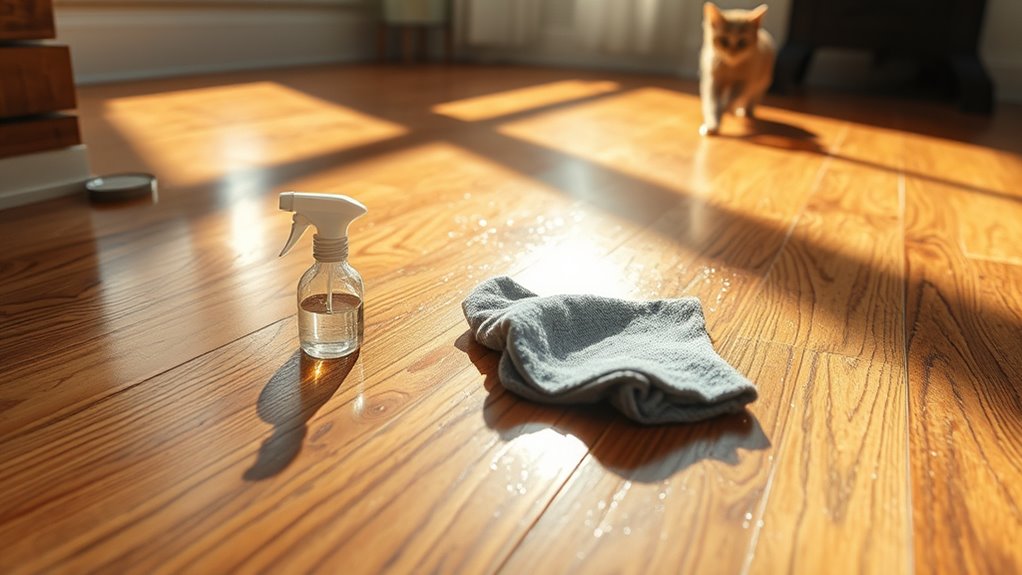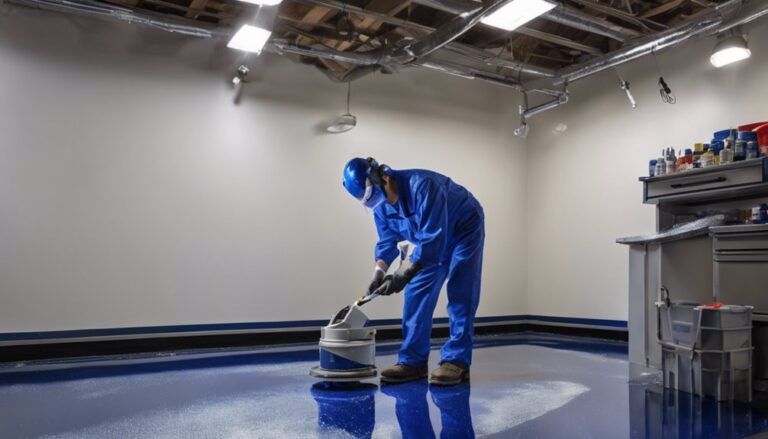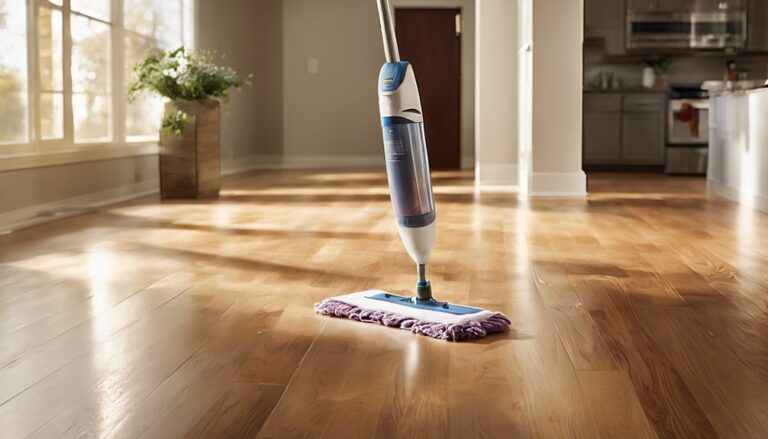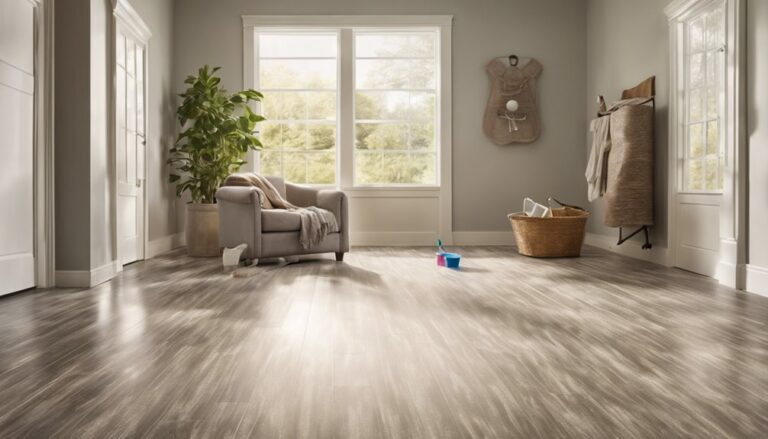If your cat pees on wood floors, act fast by blotting urine with an absorbent cloth to prevent soaking. Use a wood-safe enzymatic cleaner to break down odors and disinfect the area, then dry thoroughly. For old stains, clean gently with mild soap and a vinegar solution to neutralize smells. Proper ventilation and sealing floors help prevent future damage. Following these steps carefully protects your wood floors from stains and lingering odors. Additional tips can help you handle stubborn issues and long-term care.
Identifying Cat Urine on Wood Floors
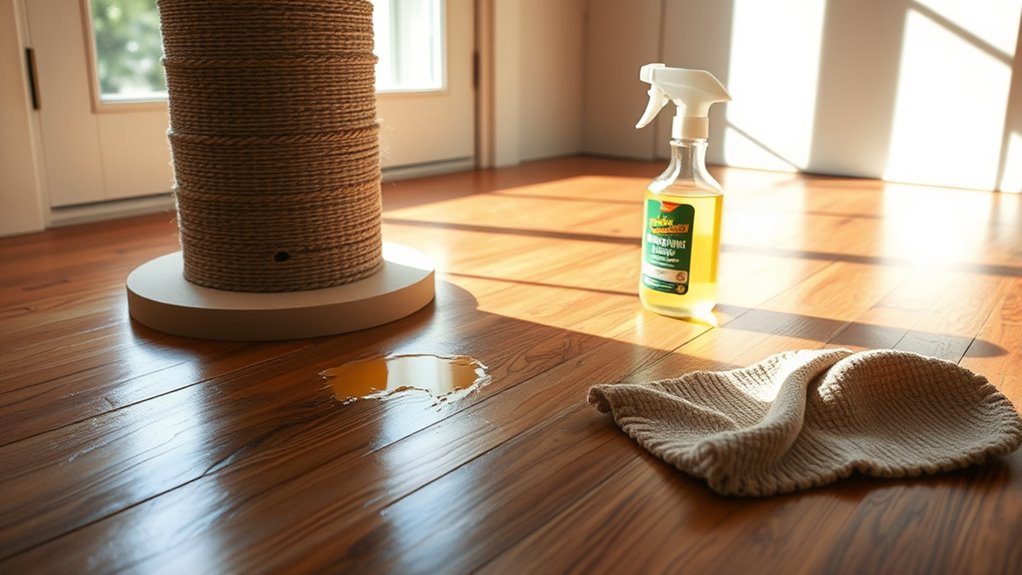
Although cat urine can sometimes be hard to spot on wood floors, you can identify it by looking for discoloration, a sticky residue, or a strong ammonia-like smell. Understanding cat behavior helps with urine detection; cats often urinate outside their litter box due to stress, marking territory, or medical issues. Look closely at areas where your cat spends time or near their litter box, as repeated accidents may cause noticeable damage. Use a blacklight to reveal urine stains invisible to the naked eye. This method highlights the extent of the problem, enabling you to target cleaning effectively. Being methodical and attentive to these signs lets you address the issue promptly, preserving your freedom to enjoy a clean, odor-free home without lingering damage to your wood floors.
Immediate Steps to Take After an Accident
As soon as you notice the accident, blot the urine quickly to prevent it from soaking deeper into the wood. Next, apply an enzyme cleaner designed to break down pet urine effectively. Finally, ventilate the area well to help dry the sol and reduce lingering odors.
Blot Urine Quickly
The moment you notice cat urine on your wood floor, act fast to blot it up. Use effective blotting techniques by gently pressing a clean, absorbent cloth or paper towel onto the spot. Avoid rubbing, as this can spread the urine or push it deeper into the wood grain. Instead, apply steady pressure to soak up as much liquid as possible. Employ urine absorbents like microfiber towels or specially designed pet stain removers to maximize absorption. Repeat this process with fresh cloths until no more moisture transfers. Quick blotting limits damage and prevents the urine from seeping further. By addressing the spill immediately and methodically, you maintain your freedom from lingering odors and stains, protecting your wood floor’s integrity with minimal effort.
Use Enzyme Cleaner
An enzyme cleaner is your best tool for breaking down cat urine proteins and eliminating odors at their source. Using enzyme cleaning techniques guarantees deep, thorough removal, preventing your cat from marking the same spot again. The benefits of enzymes include natural odor neutralization and safe use on wood floors without damage.
| Étape | Detail |
|---|---|
| Apply Enzyme Cleaner | Saturate the affected area evenly. |
| Wait | Let it sit 10-15 minutes. |
| Blot Excess | Use a clean cloth to absorb. |
| Repeat if Needed | For stubborn stains and odors. |
Follow these steps promptly to reclaim your freedom from persistent cat pee odors on wood floors.
Ventilate the Area
Although ventilating the area might seem minor, it’s essential right after a cat accident to help dissipate odors and speed up the drying process. Start by opening windows and doors to create natural air circulation. If possible, place fans strategically to push fresh air across the affected wood floor, which accelerates evaporation. These ventilation tips reduce lingering smells and prevent moisture from seeping deeper into the wood. Avoid using heaters directly on the spot, as excessive heat can damage the floor. Instead, focus on consistent airflow to maintain a dry environment. Proper ventilation not only aids in odor control but also supports the effectiveness of any cleaning products you’ve applied. By prioritizing air circulation immediately, you’re taking an important step toward restoring your wood floors and enjoying a fresh, odor-free space.
Choosing the Right Cleaning Supplies
Because cat urine can penetrate wood fibers and leave stubborn odors, choosing the right cleaning supplies is essential to effectively remove both stains and smells. You want products that are safe for your wood floors and eco friendly to protect your home environment. Here’s what to look for:
Choosing safe, eco-friendly cleaners is key to removing cat urine stains and odors from wood floors.
- Enzyme-based cleaners – they break down urine proteins without harsh chemicals.
- pH-neutral formulas – safe products that won’t damage the wood’s finish.
- Natural, biodegradable ingredients – eco friendly options that minimize toxins.
- Odor-neutralizers – specifically designed to eliminate lingering smells, not just mask them.
Avoid bleach or ammonia, as these can worsen stains and odors. By selecting targeted, safe, and eco-conscious supplies, you take control of restoring your floors while keeping your space healthy and fresh.
How to Remove Fresh Cat Urine From Wood
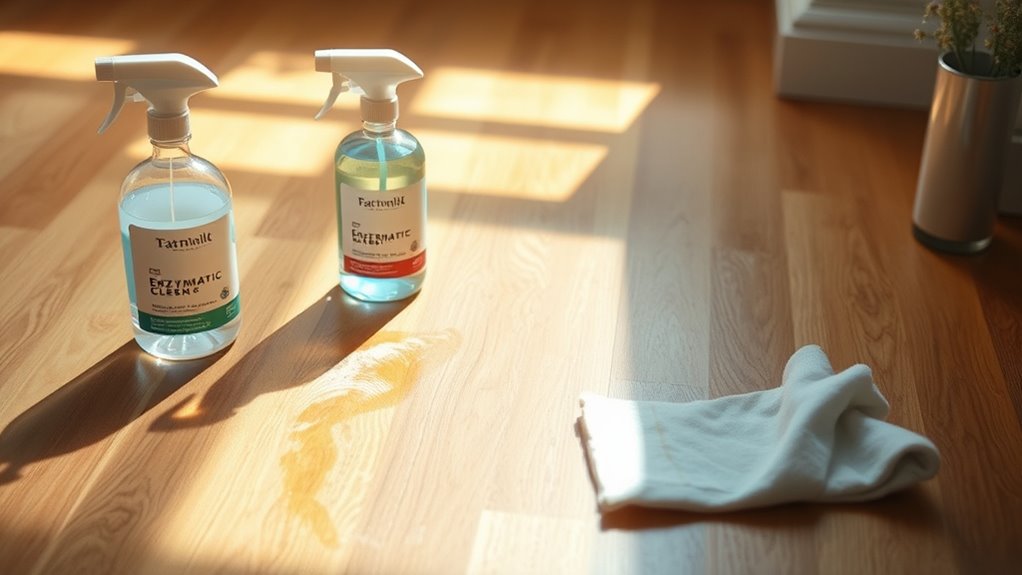
The first 15 minutes after your cat urinates on wood floors are crucial for effective cleaning. Start by using paper towels to blot the urine—avoid rubbing, which spreads the mess. Urine detection is essential here; a UV light can help you spot hidden spots. Once soaked, apply a wood-safe enzymatic cleaner, following the instructions carefully. These cleaning techniques break down urine compounds, preventing odors and stains. Don’t oversaturate the wood to avoid damage. After treatment, wipe the area with a damp cloth, then dry it thoroughly. Proper ventilation speeds up drying and reduces lingering smells. Acting promptly preserves your wood floor’s finish and keeps your space fresh, giving you the freedom to enjoy a clean, odor-free home without hassle.
Techniques for Cleaning Old Cat Pee Stains
Older cat pee stains on wood floors can be tougher to remove, but with the right techniques, you can still restore your floor’s appearance and freshness. When dealing with old stains, focus on thorough cleaning techniques that target deep-set odors and discoloration.
- Start by gently scrubbing the area with a mixture of warm water and mild dish soap to lift surface residues.
- Use a soft brush to avoid damaging the wood while loosening embedded stains.
- Apply a vinegar and water solution (1:1 ratio) to neutralize odors; let it sit for 10 minutes before wiping clean.
- Dry the floor completely to prevent moisture damage.
These steps help break down old stains and maintain your wood floor’s integrity without harsh chemicals.
Using Enzymatic Cleaners Effectively
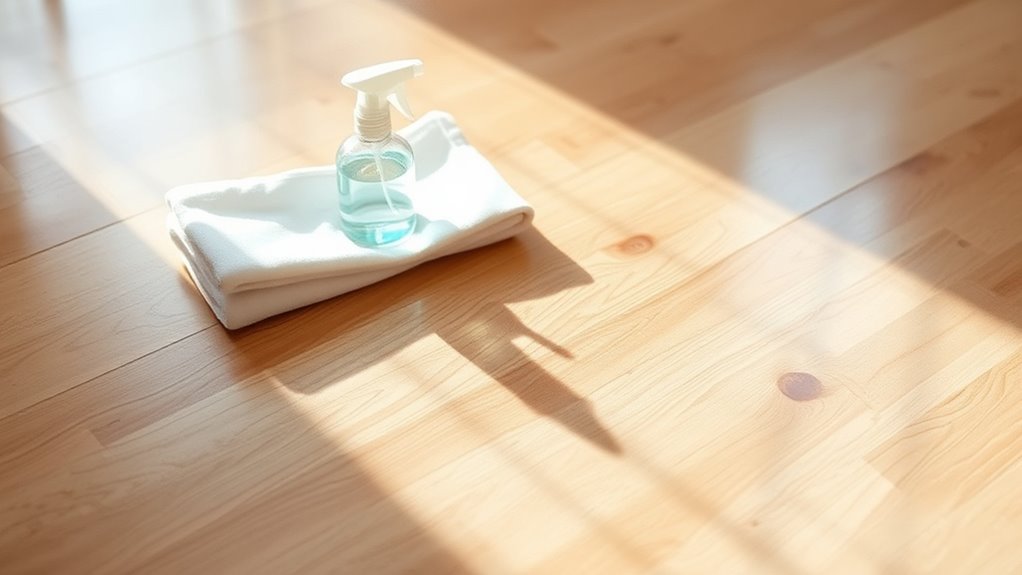
When you want to eliminate cat pee odors and stains at their source, enzymatic cleaners are your best option. These cleaners break down uric acid crystals through enzyme action, removing both visible stains and hidden odors. To use them effectively, first blot the area dry, then apply the cleaner generously, ensuring it soaks into the wood grain. Follow the manufacturer’s instructions for dwell time to maximize enzyme activity. Avoid rinsing immediately—enzymes need time to work. Cleaning frequency matters; treat fresh accidents promptly to prevent deep penetration. For older stains, multiple applications may be necessary. Consistent use of enzymatic cleaners not only removes current messes but also reduces your cat’s chances of re-marking. Staying methodical and timely with these treatments helps maintain your wood floors odor-free and stain-free.
Preventing Odor From Penetrating the Wood
To stop cat pee odor from soaking into your wood floors, you’ll want to seal the surfaces with a protective finish. Applying odor blockers helps neutralize any lingering smells before they set in. Also, keeping the area well-ventilated speeds up drying and prevents odors from becoming trapped.
Seal Wood Surfaces
A sealed wood surface acts as a barrier that prevents cat urine odors from soaking into the grain and causing long-lasting smells. To protect your floors effectively, focus on proper wood floor sealing with high-quality protective finishes. Follow these steps:
- Clean and dry the wood thoroughly to remove any residue.
- Choose a protective finish designed for wood floors, such as polyurethane or epoxy.
- Apply the finish evenly with a brush or roller, covering all surfaces.
- Allow adequate drying time before letting pets back in the area.
Use Odor Blockers
Although sealing your wood floors provides a solid defense, using odor blockers adds an extra layer of protection by neutralizing and preventing cat urine smells from sinking into the wood. You’ll want to apply odor absorption techniques that target and eliminate odors at their source. Natural odor neutralizers like baking soda, activated charcoal, or white vinegar are effective and safe options. Sprinkle baking soda over affected areas, let it sit for several hours, then vacuum it up. Alternatively, place bowls of activated charcoal nearby to absorb lingering smells. You can also lightly wipe the floor with a diluted vinegar solution to neutralize odors without damaging the wood. By incorporating these odor blockers, you’ll keep your floors fresh and free from persistent cat urine scents, maintaining a clean, odor-free environment.
Maintain Proper Ventilation
Neutralizing odors with baking soda or vinegar helps, but without proper airflow, those smells can still linger and seep deeper into the wood. To prevent this, maintaining good ventilation is key. You’ll want to focus on effective ventilation techniques that promote consistent air circulation. Here’s how:
- Open windows and doors when cleaning to let fresh air flow through.
- Use fans strategically to boost air movement across the affected area.
- Consider a dehumidifier to reduce moisture, which can trap odors.
- Keep HVAC filters clean to guarantee efficient air exchange.
Dealing With Persistent Smells and Stains
When cat pee has soaked into wood floors, the lingering smell and stains can be tough to eliminate. To tackle this, start with smell neutralization by applying an enzymatic cleaner designed for pet odors. These break down urine compounds, removing the source rather than masking the scent. Next, address stains by gently scrubbing the affected area with a mixture of white vinegar and water; this helps lift discoloration without damaging the wood. Avoid harsh chemicals that might worsen stains or finish damage. After cleaning, dry the area thoroughly to prevent moisture buildup, which can worsen odors and stains. Consistently applying these steps guarantees effective stain prevention and odor control, allowing your floors to regain their natural look and freedom from persistent cat pee residues.
Protecting Your Wood Floors From Future Accidents
To keep your wood floors safe from future cat pee accidents, you’ll need to combine prevention with protective measures. Understanding cat behavior is key; cats often mark territory or react to stress. Here’s how you can protect your floors:
- Use washable rugs or mats in problem areas to catch accidents early.
- Apply a pet-safe sealant on wood floors to create a moisture barrier.
- Keep litter boxes clean and in quiet, accessible spots to encourage use.
- Address any behavioral issues by consulting your vet or a behaviorist.
These preventive measures reduce the risk of damage and maintain your freedom to enjoy a clean, odor-free home. By staying proactive, you protect your investment and your peace of mind.
When to Call a Professional Cleaner
If you notice the odor won’t fade or stains have set deep into your wood floors, it might be time to call a professional cleaner. They have specialized equipment and solutions that go beyond typical home treatments. Don’t wait too long, as early professional intervention can prevent lasting damage.
Persistent Odor Issues
Although many cat urine stains can be treated effectively at home, persistent odors often signal a deeper problem within your wood floors. Persistent odor causes usually include urine seeping into cracks or the subfloor, making DIY methods ineffective. To guarantee long term solutions, consider these steps before calling a professional:
- Identify all affected areas—even hidden spots beneath rugs or furniture.
- Try enzymatic cleaners designed to break down urine compounds.
- If odors linger after thorough cleaning, it’s time to seek expert help.
- Professionals use specialized equipment and treatments to reach deep layers and neutralize smells permanently.
Don’t let persistent odors restrict your comfort—getting professional assistance is often the best way to reclaim your space’s freshness and freedom.
Deep Stain Removal
When deep stains have set into your wood floors, home remedies might not be enough to restore their appearance. At this point, it’s wise to contemplate a professional cleaner who can perform a thorough deep clean and effective stain treatment tailored to wood surfaces. Professionals use specialized techniques that penetrate the wood, removing embedded urine and preventing further damage. If DIY methods haven’t worked after multiple attempts, or if the stain is extensive, a professional’s expertise guarantees the floor is treated without harming the finish. Calling in help also saves you time and effort, letting you regain your freedom from persistent odors and unsightly marks. Don’t hesitate to seek professional assistance—it’s often the most reliable way to fully restore your wood floors.
Specialized Cleaning Equipment
Because cat urine can penetrate deep into wood grain and finish, specialized cleaning equipment is often necessary to fully eliminate stains and odors. You might want to call a professional cleaner if your DIY efforts fall short or the damage is extensive. Professionals use advanced tools like steam cleaners and vacuum extractors that reach deep into the wood, removing urine residues and neutralizing odors effectively.
Here’s when to contemplate professional help:
- Persistent odors remain despite cleaning attempts.
- Stains have penetrated beyond surface layers.
- You lack access to steam cleaners or vacuum extractors.
- You want to avoid damaging your wood floors with harsh chemicals.
Using the right equipment guarantees your floors regain their natural beauty and smell fresh again.

